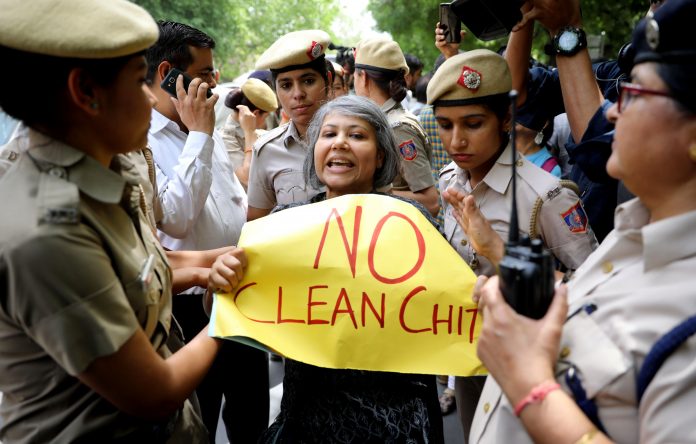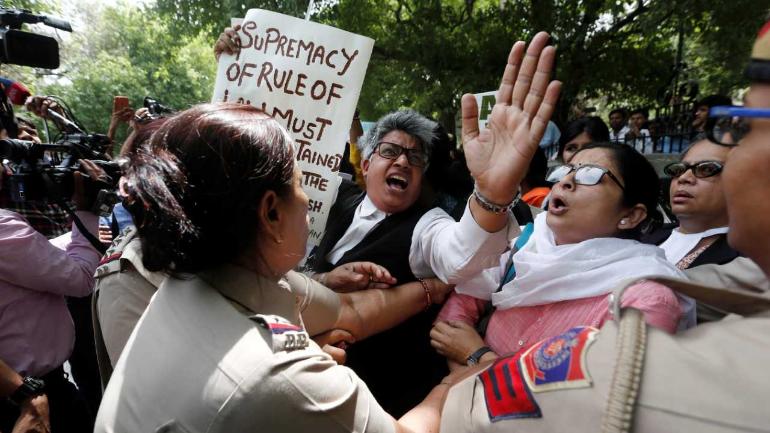Over the past two days, the hashtag #SupremeInjustice has been surfacing on Twitter and social media, condemning CJI Gogoi receiving a clean chit regarding sexual harassment charges. The hashtag emerged from the public protests staged across various Indian cities, which oppose the arbitrary way in which the complaint was deemed to have ‘no substance.’ The protesters scattered across Delhi, Bangalore, Hyderabad, Mumbai and Ahmedabad are also demanding for an independent and credible inquiry into the case. On 7th & 8th April in Delhi, and later in Bangalore and Ahmedabad, non-violent groups of protesters were stopped and detained. The protests were interrupted and protesters met with the police force, undermining the basic right to dissent.
Thickening Silence
The charge of sexual harassment against Gogoi was made on April 20, when a former employee of the Supreme Court submitted a detailed complaint against him. After the complaint, an emergency bench was constituted to hear the case. The lawfulness of the bench has been questioned by women lawyers, since it did not follow the norms of due process that are supposed to be in place for cases of workplace sexual harassment. For instance, there were no women present at the emergency bench. Additionally, the whole hearing was an ‘in-house’ one, which meant that no external members were consulted. Most shocking of all, the Chief Justice was part of the emergency bench to hear his own case. What comes through in all of this is a commitment to silence and secrecy – a commitment that comes at the cost of a credible procedure, natural justice, and fair outcomes for women.
Also read: Feminist Activists & Groups Release A Statement On The CJI Sexual Harassment Case
In the light of the recent detainment of protesters, what seems to be a plot of silence at various levels is only thickening. From the very beginning, the complainant has faced numerous hurdles, starting from being dismissed from her job. Her allegations being dubbed as ‘wild & scandalous’ and as a conspiracy to malign the Supreme Court are classic examples of using emotional rhetoric to discredit the legitimacy of complaints. More recently, the complainant withdrew from the hearing of her case for various hostile reasons, including not being allowed legal representation during the process.

What comes through in all of this is a commitment to silence and secrecy – a commitment that comes at the cost of a credible procedure, natural justice and fair outcomes for women.
The situation worsens at the level of legal procedure. For one, the more recent inquiry committee that was set up to look into the case has declared that the report acquiting Gogoi will not be made public, not to mention the absurdity of Gogoi being present in his own emergency bench earlier in April. When the complainant is not supported, and due process is shrouded by thorny silence, the next logical route remaining is for the public to protest and demand justice and transparency. The fact that even the protesting members of the public have been detained shows how far powerful institutions will reach, even collude with state forces to muffle voices and protect the integrity of men accused of predatory, criminal behaviour.
As has been noted earlier, there were, in fact, more police than protesters present at the site of peaceful protest in Delhi. Nandana (name changed), who participated in the protest in Delhi, said, “We were detained on the first and second days of the protest. We were dragged and pushed onto buses on the first day when we protested in front of the Supreme Court. There were three women grabbing me at once, and some of us had bruises on our arm.” Similarly, in Bangalore, protesters were taken to the police station minutes into the protest.
Even after multiple waves of #MeToo in the country, the attempts to silence women for speaking out against sexual harassment are as heavy-handed as ever. When a man accused of sexual harassment receives ‘clean chit,’ with ease, but lawful protesters are slapped with Section 144, it reveals the glaring, almost bizarre contradictions that arise in instances of sexual harassment. The CJI Gogoi case has witnessed a multitude of overlapping silences – from discrediting the complainant, failing to adhere to proper standards of due process, to now finally, restraining the voices of citizens who are well within their rights to protest and demand justice.
The Pangs of Due Process
In October 2017, when Raya Sarkar published a list of sexual harassers in academia on Facebook, the instant backlash from a group of established feminists were hinged around a few concerns, the most pressing one being- ‘What about due process?’ The subsequent wave of #MeToo that broke open in media circuits after this reinforced the same fears- the idea that women were simply going rogue by exposing their harassers unabashedly instead of taking things up the ‘correct’ way by using legal recourse or ‘due process.’ But is due process always just?
What happens to due process when enormous power and influence separate the complainant and the accused?
And even after the legacy of survivors like Bhanwari Devi and decisive judicial activism leading up to the Vishakha Guidlines, which stipulate laws against workplace sexual harassment in India, there are countless examples from recent history which indicate that due process isn’t always straight-forward, just or fair. As in the CJI case, what happens to due process when enormous power and influence separate the complainant and the accused?
What happens when one challenges the inner workings of one of India’s most powerful institutions? The treatment of protesters in major cities proves that when the right to seek fair procedure is diluted at one level, it spills over and curtails other freedoms as well; in this case the freedom to protest. When asked about the detainment, Nandana, who feels strongly about the protest said, “The right to dissent is integral to democracy. When ‘due process’ has been so blatantly ignored in this case, why are we not allowed to speak?”
Image Source: India Today
About the author(s)
Anagha is pursuing her MA in Media & Culture from TISS Mumbai.




